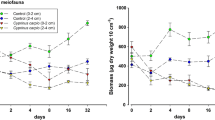Abstract
In two mesocosm experiments of cross-classified design, using sixteen 900-liter containers, we measured how benthivorous, omnivorous, and planktivorous fish interact with the sediment-water interface to influence planktonic and benthic production. Experiment 1 used three fish treatments (Ictalurus punctatus, Notemigonus crysoleucas, Lepomis macrochirus) and a fishless control in the presence or absence of a natural pond sediment layer. The benthivorous Ictalurus enhanced turbidity but had no effects on dissolved oxygen, diel changes in dissolved oxygen, pH, or nutrient concentrations. All parameters measured were unaffected by the planktivorous Notemigonus. Experiment 2 compared Ictalurus nebulosus with those of other benthivorous (Cyprinus carpio) and omnivorous (Dorosoma cepedianum) fish, again in the presence or absence of a sediment layer but at a higher stocking density than experiment 1. In the second experiment, Dorosoma enhanced dissolved oxygen levels but had no effect on turbidity while Cyprinus and Ictalurus enhanced turbidity but suppressed dissolved oxygen. Nitrogen concentrations in sediment tubs were enhanced by Cyprinus and Ictalurus but nitrogen concentrations in sediment-free tubs were enhanced by Dorosoma. This would suggest that the benthivores affected nutrient levels through resuspension of sediments while omnivores affected nutrient levels through physiological processes.
Similar content being viewed by others
References
American Public Health Association (APHA) et al., 1985. Standard methods for the examination of water and waste-water. 16th ed. American Public Health Association, Washington. D.C.
Andersson, G., H. Berggren, G. Cronberg & C. Gelin, 1978. Effects of planktivorous and benthivorous fish on organisms and water chemistry in eutrophic lakes. Hydrobiologia 59: 9–15.
Arruda, J. A., G. R. Marzolf & R. T. Faulk, 1983. The role of suspended sediments in the nutrition of zooplankton in turbid Reservoirs. Ecology 64: 1225–1235.
Grobbelaar, J. U., 1985. Phytoplankton productivity in turbid waters. J. Plankton Res. 7: 653–663.
Grobbelaar, J. U. & P. Stegmann, 1976. Biological assessment of the euphotic zone in a turbid man-made lake. Hydrobiologia 48: 236–266.
Hart, R. C., 1986. Zooplankton abundance, community structure and dynamics in relation to inorganic turbidity, and their implications for a potential fishery in subtropical Lake le Roux, South Africa. Freshwat. Biol. 16: 351–371.
Havens, K. E., 1991. Fish-induced sediment resuspension: effects on phytoplankton biomass and community structure in a shallow hypereutrophic lake. J. Plankton Res. 13: 1163–1176.
Keen, W. H. & J. Gagliardi 1981. Effect of brown bullheads on release of phosphorus in sediment and water systems. Prog. Fish-Cult. 43: 183–185.
Kirk, J. T. O., 1985. Effects of suspensoids (turbidity) on penetration of solar radiation in aquatic ecosystems. Hydrobiologia 125/Dev. Hydrobiol. 28: 195–208.
Kitchell, J. F., J. F. Koonce & P. S. Tennis, 1975. Phosphorus flux through fishes. Verh. int. Ver. Limnol. 19: 2478–2484.
Lamarra, V. A., 1975. Digestive activities of Carp as a major contributor to the nutrient loading of lakes. Verh. int. Ver. Limnol. 19: 2461–2468.
McQueen, D. J., J. R. Post & E. L. Mills, 1986. Trophic relationships in freshwater pelagic ecosystems. Can. J. Fish. aquat. Sci. 43: 1571–1581.
Mundahl, N. D. & T. E. Wissing, 1987. Nutritional importance of detritivory in the growth and condition of gizzard shad in an Ohio reservoir. Envir. Biol. Fishes 20: 129–142.
Qin, J. & S. T. Threlkeld, 1990. Experimental comparison of the effects of benthivorous fish and planktivorous fish on plankton community structure. Arch. Hydrobiol. 119: 121–141.
SAS Institute Inc., 1985. SAS user's guide: statistics, 1985 ed. SAS Institute, Inc.
Threlkeld, S. T. & D. M. Soballe, 1988. Effects of mineral turbidity on freshwater plankton communities: three exploratory tank experiments of factorial design. Hydrobiologia 159: 213–226.
Werner, E. E., G. G. Mittelbach, D. G. Hall & J. F. Gilliam, 1983. Experimental tests of optimal habitat use in fish: the role of relative habitat profitability. Ecology 64: 1525–1539.
Author information
Authors and Affiliations
Rights and permissions
About this article
Cite this article
Cline, J.M., East, T.L. & Threlkeld, S.T. Fish interactions with the sediment-water interface. Hydrobiologia 275, 301–311 (1994). https://doi.org/10.1007/BF00026721
Issue Date:
DOI: https://doi.org/10.1007/BF00026721




